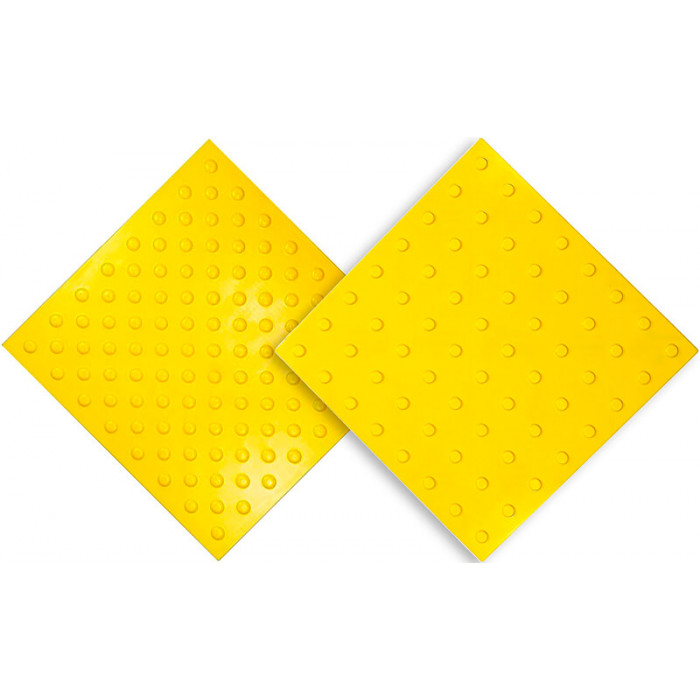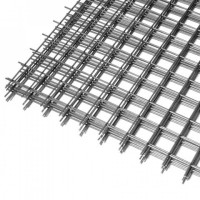Brovary tactile tiles, storm water inlets (storm water inlets), fiberglass, drill pipes, drill bit
Tactile tiles are necessary for the organization of accessible movement of people with visual impairment in public buildings and premises, as well as on the street. This type of tactile indicators “shows” the direction of movement to a blind person and warns of obstacles in his path.
Appointment of tactile tiles
The type of tactile pattern determines the purpose of the tile:
warning - with cone-shaped reefs;
guide - with diagonal and longitudinal reefs.
Warning signs are used to make a person with a disability aware of potential hazards along the way, while guides are used to indicate the direction of travel on a straight section or when turning.
The requirements for the arrangement of tactile signs of various types and for various purposes at facilities should be reflected in design assignments for construction, reconstruction, overhaul, as well as in documents for the current repair and "reasonable adaptation" of facilities.
All tactile tiles, regardless of the purpose, material used and technology of arrangement, to ensure their identification by visually impaired people, must be yellow when arranged on a dark surface or black when arranged on a light surface.
Product Performance
Polyurethane (PU) tactile signs for disabled people can be installed indoors and outdoors, while signs made of polyvinyl chloride (PVC) are used only inside buildings. Both types of products are mounted with screws or adhesives, have an attractive appearance, safety and durability.
Metal tactile tiles are used in places with higher traffic, such as train stations, airports, shopping centers and others.
The materials are anti-slip and wear resistant. Tactile tiles for indoors and outdoors are resistant to precipitation, temperature extremes, UV rays and chemicals. Increased strength indicators are designed for the use of the coating in conditions of heavy traffic. It is these high performance characteristics that determine the cost of tactile tiles for the visually impaired.
Areas of application for tactile tiles
There are many applications of tactile tiles that help people with various disabilities navigate the urban environment and move around safely:
Public Transport: Tactile tiles are installed on platforms, stops and subways to indicate where to queue and where the edge of the platform is.
Urban Environment: Tactile tiles help seniors and people with disabilities navigate streets, parking lots, around buildings, and across pedestrian crossings.
Medical facilities: In hospitals and rehabilitation centers, tactile tiles are used to indicate where to go after surgery, where medical equipment is located, etc.
Education: In schools and universities, tactile tiles provide guidance to people with visual impairments and disabilities.
Trade: At retail facilities, tactile tiles are installed to indicate places where cash desks, toilets, elevators and other objects are located.
Where are tactile tiles used?
Tactile tiles are widely used in urban environments to create safety and comfort for people with disabilities. It is installed in several areas such as squares, sidewalks, overpasses and railroad tracks.
This type of tile is also used in buildings to guide people to the exit, as well as to prevent accidents on stairs and other places with an increased risk of injury.
Tactile tiles can be used at intersections, where they are used to indicate where pedestrians need to stop and also to prohibit movement onto the road.
Tactile tiles are also used on parking signs, where they are used to indicate wheelchair stalls and other facilities to facilitate the movement of people with disabilities.
Types and types of tactile tiles for the visually impaired
Colour: yellow (RAL 1016), gray and others
The main requirement for tiles in color is contrast with the base layer. Yellow (RAL 1003-1007, 1012, 1016, 1018) is considered optimal for tactile ground indicators as the most contrasting for a dark background, as well as black (RAL 9004, 9005, 9011, 9017) for a light background.
Gray tiles can be used for bright bases such as yellow or red floors.
In cases where the contrasting color violates the appearance of cultural heritage monuments (paragraphs 4.1.14 and 4.1.17 of GOST R 52875-2018), it is allowed to install a heat pump unit to match the color of the floor covering.
Material: What are outdoor tactile signs made of?
For mounting outdoor tactile aids on the pavementThese paths use the following basic technologies and materials:
laying concrete and stone tactile slabs;
application of tactile indicators based on a two-layer polymer coating (PVC) to the surface;
installation on the surface of tactile elements made of polyurethane materials (TPU).
Given the durability and low cost, concrete tactile tiles are the most profitable option for marking street space.
Types of corrugation
The tactile tile device carries various information about the environment.
Longitudinal reefs / bands
Tiles with longitudinal reefs usually show the direction of safe movement. If the sign consists of a wide ribbon of plates with longitudinal reefs, then we have an exit zone from the sidewalk to the pedestrian crossing. If the sign is a wide ribbon of slabs with transverse reefs, then we have a “Field of Attention”, “Field for Receiving Services” or “Field for Boarding Shuttle Vehicles”.
Dimensions: length, width, thickness
The thickness of the tile is the sum of the thickness of the base layer (usually 50 mm) and the thickness of the reefs. The thickness of the reef, in accordance with the new GOST R 52875-2018, varies from 3 to 5 mm, depending on the purpose of the tile.
300x300. Standard dimensions from GOST, in mm. It is possible to manufacture tiles with rectilinear parallel reefs (6 pcs), with truncated cones in a checkerboard or linear pattern.
400x400. One of the options for an individual order. 400x400mm can be handy when larger slabs are too big for the surface to be repaired.
500x500. Standard sizes from GOST. It is possible to manufacture tiles with rectilinear parallel reefs (9 pcs), with truncated cones in a checkerboard or linear order.
600x600. A concrete tile of this size will consist of four combined 300x300 mm tile shapes.
Tactile floor tiles are mainly located indoors, in transport service buildings, in rehabilitation, sanatorium and medical institutions, where disabled people are treated and restored. This tile is for informational purposes only. The stripes printed on it indicate the direction of movement.
The most popular indoor tactile tile is PVC polymer coating. It is easy to install and has high wear resistance. For the price, this tile is cheaper than other analogues.
The second most popular can be considered polyurethane tiles (PU). In terms of strength and performance, it even surpasses PVC. It can be installed both indoors and outdoors. The only downside to PU tiles is that they are more expensive.
In the premises, quite widely, metal tiles are used. It is valued for its high strength characteristics in operation. Due to its excellent aesthetic appearance, it is used in offices and banks. But in the price segment it is considered expensive.
And ceramic tiles. Due to acoustic perception, it helps visually impaired and blind people to determine the path to follow. It is applied at stations, at the airports. It is not expensive, because it has lower performance. Tactile tiles are used so that people with disabilities who are blind can feel with their feet where the stepped descent into the metro begins and ends, where the right-hand and left-hand traffic on the sidewalk is. Such tiles are laid in the center of the sidewalks. They are also laid in places where people with poor vision and the blind can trip or hit themselves. For example, at the entrance to a shopping center or metro, in front of the entrance doors, in front of a pedestrian crossing, which is additionally equipped with sound signals or a voice recording that says when you can or cannot cross the street.
No questions about this product, be the first and ask your question.


